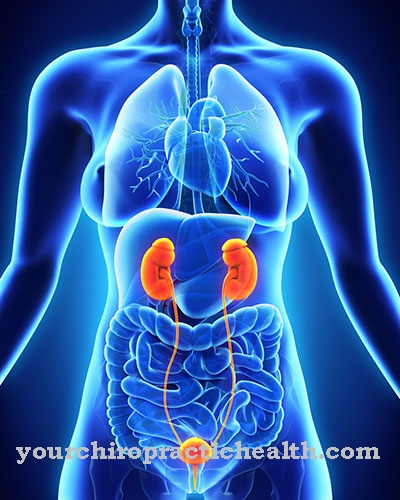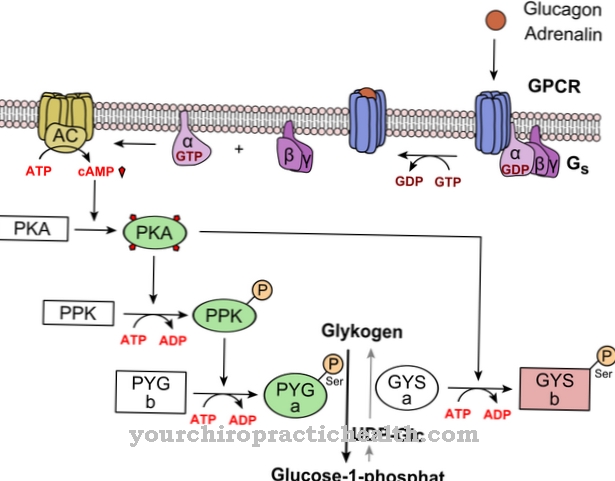Trachoma, Conjunctivitis trachomatosa, Egyptian eye inflammation, grain disease of the eyes: a trachoma is a disease with many names. As different as it has different names, it is also dangerous, because if left untreated, the trachoma can lead to blindness in the affected person when it reaches the end phase.
What is a trachoma?

© fotoliaxrender - stock.adobe.com
As Trachoma is a disease of the eyes in which, more precisely, the conjunctiva becomes chronically inflamed. Doctors differentiate between four stages with regard to the course. The first phase usually begins after an incubation period of up to two weeks has elapsed. This describes the time after infection until the onset of the first symptoms.
Characteristic of this phase is the occurrence of conjunctivitis (conjunctivitis). In addition, there are other symptoms typical of conjunctivitis, such as feelings of foreign bodies in the eyes, reddened whites of the eyes and the formation of secretions at the corners of the eyes, which indicate the excretion of bacteria that have already died. In the following second phase, the upper eyelid lymph follicles form on the conjunctiva, so that the conjunctiva feels "rough".
Furthermore, the eyes swell due to the persistent inflammation; in extreme cases, the upper eyelids hang down in an unnatural way. In the third phase, the lymph follicles formed in the second phase burst; The result is scarring. If the trachoma remains untreated, the fourth and last phase of the disease occurs. The resulting scars literally pull the lids together so that the lids have to give in to the pressure and the lashes protrude into the eyes.
With every blink of the eye, the eyelashes rub against the surface of the eye, which is injured and can become inflamed upon contact with other pathogens. If left untreated, serious eye injuries can be caused, which can lead to blindness as a result of the trachoma.
causes
This is evoked Trachoma by serotypes A, B and C of the bacterium Chlamydia trachomatis. The bacterium is mainly found in regions with poor hygienic conditions. Due to this fact, trachoma is largely eradicated in industrialized countries.
As a bacterium, the pathogen prefers a warm, humid environment. Since an infection can occur through smear infection with already infected people or with contaminated objects, shared towels, items of clothing and public washing places are considered sources of infection for trachomas.
Symptoms, ailments & signs
The bacterium that causes the disease has an incubation period of five to twelve days after which the individual symptoms of conjunctivitis or irritation, such as red eye, are similar. Without reinfection, however, the inflammation gradually subsides.
Conjunctivitis is known as "active trachoma" and occurs particularly in preschool children. It is characterized by white lumps on the underside of the upper eyelid, as well as non-specific inflammation and thickening, often accompanied by bulges. An active trachoma is often accompanied by a watery discharge. A secondary bacterial infection can occur and cause a purulent discharge.
The later structural changes in the trachoma are called "scarred trachoma". These include scars on the eyelid that cause the eyelid to be distorted. Most often, children with active trachoma will not have any symptoms because the mild irritation and eye discharge are often considered normal.
However, other symptoms may include: discharge from the eye, swollen eyelids, trichiasis (eyelashes that rub against the eyeball), swelling of the lymph nodes at the front of the ears, sensitivity to bright light, increased pulse, other complications of the throat and nose.The main complication is the so-called corneal ulcer, which arises due to excessive rubbing or trichiasis with superimposed bacterial infection.
Diagnosis & course
Among the first diagnostic measures of Trachomas belongs to the clinical picture. Advanced cases, in particular, can be identified with a visual diagnosis due to their relatively relevant clinical picture.
Statements by the patient that the symptoms keep recurring are also considered reliable indicators of the presence of a trachoma. Nonetheless, precisely because of the serious consequences of a misdiagnosis, it cannot stay that way. Therefore, a smear is added as a further diagnostic measure. Here, tiny tissue samples are taken from the conjunctiva of the affected person and examined in the laboratory for possible pathogens.
When the pathogen Chlamydia trachomatis is identified, a trachoma can be assumed with absolute certainty. This diagnosis is particularly important insofar as cases of disease in the early stages of a trachoma look deceptively similar to ordinary conjunctivitis.
When should you go to the doctor?
Disorders of the functional activity of the eyes are signs of a health impairment. If they persist or if they increase in scope and intensity, a doctor will be needed. If the eyesight is impaired due to an overload situation, in most cases a period of rest or rest is sufficient. If the eyesight is then completely restored, no doctor needs to be consulted. If impairments persist even after a break, clarification of the cause is required.
A raised body temperature, irritability, red coloring of the eyes or swelling of the lymph should be examined and treated. Hypersensitivity to the effects of light, palpitations or general irregularities in the heart rhythm should also be presented to a doctor. Changes in eye discharge, dryness in the eye, or peculiarities of the eyelid should be presented to a doctor. In the event of itching, general malaise or swollen eyes, a doctor's visit is necessary. If there is a headache, a feeling of pressure in the eye area or blurred vision, medical examinations are required for a diagnosis.
Abnormal behavior, unsteady gait or an increased risk of accidents are signs of a health problem. If the daily tasks can no longer be carried out due to the impairment of vision, the person concerned needs help. A doctor should be consulted so that necessary measures can be taken. Otherwise there is a risk of blindness in severe cases.
Treatment & Therapy
There Trachoma is a bacterial disease, it is considered to be treatable if the treatment is carried out in good time. The World Health Organization (WHO for short) recommends the so-called "SAFE therapy".
The "S" stands for surgery. The eye injuries occurring in the last stage as a result of the deformation of the eyelids should be surgically removed in order to prevent eye injuries as one of the basic requirements for later complications. The "A" stands for antibiotics with which the trachoma pathogen is to be killed.
The "F" for facial cleanliness or hygienic environment of the visual field pursues the goal of preventing at least further infections of the already weakened eye area by keeping the facial skin as free from germs as possible. After all, the "E" stands for Environmental Improvement, that is, compliance with basic hygienic rules. After all, poor hygiene is the main cause of the spread of trachoma.
You can find your medication here
➔ Medicines for eye infectionsprevention
The Trachoma is widely considered to be extinct in Europe. Above all, it is thanks to the high hygiene standards. But this doesn't just include regular hand washing. Particularly high-risk groups such as contact lens wearers should pay attention to special safety measures. For example, contact lenses should not be shared with strangers.
The same applies to all other common use items that are suitable for use on the face, such as the example already mentioned with the bath towels. However, if there is contact with a possible carrier of the pathogen, it is sufficient to disinfect the hands with 70 percent alcoholic skin disinfectants to kill the pathogens of the trachoma on the skin.
Aftercare
There are no treatment recommendations for follow-up care for trachoma. Because in the final stage of the disease, the person affected is blind. Basically he is then considered helpless and has to learn to deal with his blindness in everyday life. In order to learn how to deal with blindness, the person concerned must first be given regular psychological support.
In addition, he is dependent on an accompanying person to complete everyday tasks. But trachoma is a gradual process. If the trachoma is diagnosed in good time and treated in good time (with antibiotics or surgery on the upper eyelid), it may be the task of follow-up care to prevent a new disease of the eye. Aftercare then includes preventive measures.
It is important to eliminate the causes of the disease. Inadequate hygienic conditions almost exclusively trigger a trachoma. A new disease can be counteracted by improving general hygiene measures and adequate personal hygiene during aftercare.
In particular, the face should be washed regularly and house hygiene should be checked in general. Norms and standards should be developed and adhered to for house hygiene in order to avoid smear infections. Flies can also trigger the disease. For follow-up care for a trachoma, its spread must be contained by disinfecting measures.
You can do that yourself
Following everyday tips can sometimes prevent the onset of illness or even help recovery. Consultation with a doctor is therefore not always necessary.
The best way to avoid the symptoms of trachoma is to maintain basic hygiene standards. These are omnipresent in the western industrial nations, which is why the disease rarely occurs here. When traveling to countries with inadequate water supplies, people should definitely prefer upscale accommodations. One should never sleep in beds that have already been used. Towels that come into contact with the eyes must be fresh. The use of disinfectants is also recommended. There is a minimal risk in this country for contact lens wearers. Infection is prevented by hygienic storage and use of the visual aids.
If you have a trachoma, you should definitely consult a doctor. Self-treatment is not advisable. In the worst case, there is a risk of blindness if the disease recurs over the years. Only drug therapy with antibiotics is suitable. Other alternative healing methods beyond basic recommendations such as rest and a balanced diet are not known.



.jpg)

.jpg)
.jpg)






.jpg)

.jpg)
.jpg)











.jpg)